Colleagues in Curiosity
September 28, 2021
By Stephanie Rizzo ’09

Each summer, Rollins’ Student-Faculty Collaborative Scholarship Program pairs enterprising students with expert faculty to tackle some of the world’s toughest challenges. Explore a few of this year’s standout projects.
Confronting the effects of racial trauma. Unearthing ancient treasures. Synthesizing chemical reactions to improve drug delivery. Each summer, dozens of Rollins students and professors come together to participate in scholarly research so advanced that it’s usually only conducted at the graduate level, and this past summer’s projects were no exception.
For more than two decades, Rollins’ Student-Faculty Collaborative Scholarship Program has provided a unique opportunity for Tars to dig deep into some of the biggest questions related to science, art, social movements, the humanities, and more. It’s one of the best ways for students to engage their curiosity while garnering the kind of hands-on experience that both graduate schools and employers demand. And it’s a way for students to embed themselves within an academic community through meaningful contributions to their chosen field.
To qualify, students must submit a research proposal similar to those that professionals seeking grants or departmental funding create when applying for funding. From those proposals—between 35 and 60 every year—a committee selects which projects to fund from a budget of about $300,000 annually raised from alumni donations and institutional funds.
Once a project is approved, students spend eight weeks during the summer conducting research alongside faculty mentors, who coach them on everything from proper data collation to how to submit their findings for publication. Many students publish while others present their work at conferences, allowing them to graduate with industry-tested academic merit to their name.
This year’s projects were as impressive as ever, with the added benefit of allowing many students to return to campus just as it was opening up in the wake of the COVID-19 pandemic. Through it all, our inventive faculty and industrious students proved that they were up for the challenge of asking big questions and coming up with even bigger answers.
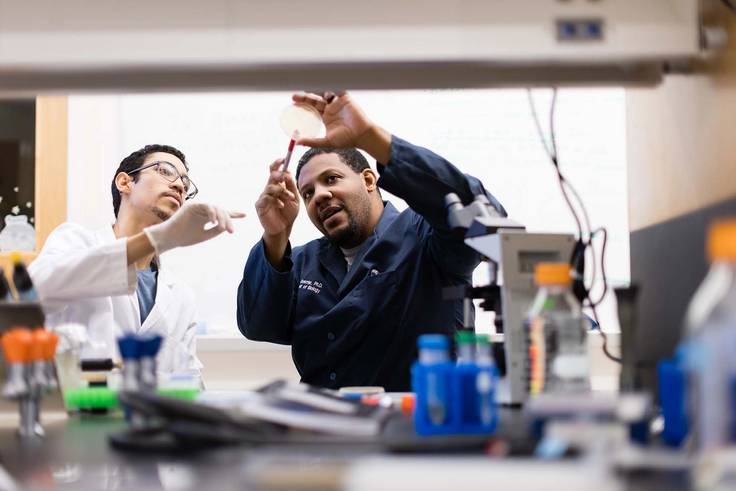
A Study of the Role of Lipid Transfer Proteins in Cell-Cell Fusion
Research Team
- Brandon Garcia ’23, marine biology major
- Sabrice Guerrier, professor of biology
The Scoop
Cell-to-cell fusion—the process whereby two cells with distinct membranes come together to form a single membrane—is one of life’s most basic processes. It’s how sperm and egg cells initially come together during fertilization, and it’s the process some viruses use to invade healthy cells and spread their genetic material through the body. Yet despite its ubiquity, cell fusion still holds plenty of mystery.
Marine biology major Brandon Garcia ’23 spent the summer working with biology professor Sabrice Guerrier in an attempt to unravel one of those mysteries. The duo looked at the role of reticulon, a protein found in organelle membranes, in the fusion of cells within Tetrahymena thermophila, a freshwater organism. During reproduction, two T. thermophila must fuse membranes in order to switch genetic material. The site at which fusion occurs is known as the conjugation junction, and research shows that reticulon is always present during conjugation. But is its presence essential to the formation of pairs or circumstantial? Using cloning techniques, Garcia and Guerrier replicated parts of T. thermophila’s DNA with and without the protein reticulon.
“At times, we would receive DNA sequencing results that were not quite what we had hoped for,” says Garcia. “But this allowed us to analyze which factors could have caused the undesired outcome. This enabled us to tackle the issue again at a different angle and, ultimately, yield successful results.”
After weeks of experimentation, they found that reticulon does indeed affect a cell’s ability to form pairs, and thus must also play a significant role in cell-cell fusion.
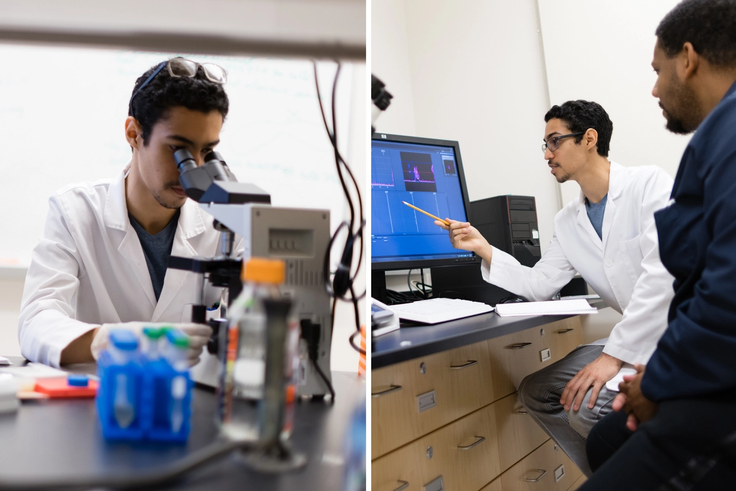
Real-World Application
Cell fusion technology has limitless applications—everything from gene mapping to the development of antibody therapies uses cell fusion to produce results. By determining the role of reticulon in the successful formation of pairs, Garcia and Guerrier’s research could lead to more efficient usage of cell-fusion technology across many industries.
Student Perspective
“When Dr. Guerrier reached out to me about participating in research, he said it was because of the curiosity I demonstrated in class,” says Garcia. “I’ve always been excited to learn more, and this research is no exception. I’m looking forward to bringing my newfound lab skills into the classroom this fall, and my experience over the summer has given me better insight into those processes. I was able to think critically about the importance of the research we were doing, which promoted independent thinking and confidence building.”
What’s Next
Garcia and Guerrier have compiled their findings into a paper, which they plan to submit for publication. The pair have also applied to several conferences in the hope of presenting their research to the academic community.
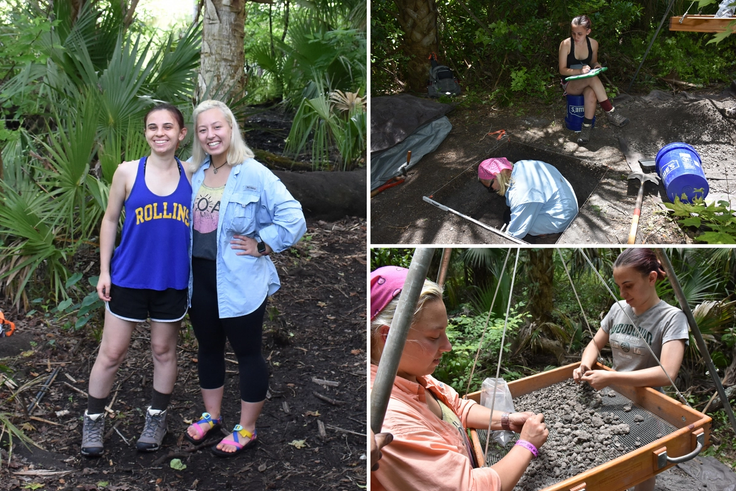
Archaeology of Shell Island
Research Team
- Zoe Millburn ’22, anthropology major
- Ellie Minette ’22, anthropology major
- Zack Gilmore, professor of anthropology
The Scoop
For more than a century, scores of Rollins students have studied on Shell Island, a small inholding located in the Wekiva Springs State Park just 20 minutes east of campus. During that time, the island has been used as a retreat, an outdoor classroom, and—in the 1970s and ’80s after the College purchased it—as an archeological site. Multiple excavations yielded more than 11,000 individual artifacts, which were left unstudied in the Rollins College Archaeology Lab for almost 50 years. That is, until anthropology majors Zoe Millburn ’22, Ellie Minette ’22, and anthropology professor Zack Gilmore began painstakingly cataloging each item.
“Once the collection was cataloged and the information digitalized, we started to plan for an excavation of our own,” says Minette. “Our excavation would provide comparative results that would help us make sense of the previous excavations. Along with very little study and cataloging, there are few notes detailing how the excavations were done. I was focused on reconstructing the archaeological history of the island, while Zoe was focused on the cultural history provided by the existing artifact collection and anything yielded from our excavation.”
The island is only reachable by boat, so every morning, Millburn, Minette, Gilmore, and a handful of student volunteers kayaked up the Wekiva River to reach their destination. The team used soil samples to determine where the old excavations would have taken place. Once they located a dig site, they carefully excavated it one meter at a time. Back in the lab, radiocarbon dating showed some of the artifacts that they recovered were more than 6,000 years old, predating European contact by centuries.
“We collaborated with the Florida Public Archaeology Network (FPAN) and the Orange County Regional History Center,” adds Minette. “FPAN helped us with our fieldwork and the creation of digital models of Shell Island artifacts. The History Center has artifacts from Shell Island displayed on loan from the Rollins College Archaeology Lab. We created digital models of these artifacts, which enables us to study them in our own lab. Another cool thing about the models is that they’re publicly available to be viewed by anyone.”

Real-World Application
The island’s cache of artifacts serves as a crucial component in understanding indigenous people in pre-Colombian Florida. Yet they were of little use to the scientific community prior to categorization. Gilmore, Millburn, and Minette’s work will serve to set scientists up for success for years after the project’s completion.
“Our project this summer at Shell Island not only provided Ellie and Zoe with the invaluable experience of participating in every step of the archaeological research process, but also enabled us to shed light on a poorly understood and largely neglected period of Florida’s indigenous history,” says Gilmore. “Our results helped fulfill the ethical responsibilities stemming from Rollins’ past excavations at the site and will help make the College a more effective steward of the island’s considerable cultural resources moving forward.”
Student Perspective
“I began working with the Shell Island collection my sophomore year, which means this project has spanned most of my time here at Rollins,” says Millburn. “It has influenced which classes I wanted to take and has helped me understand which aspects of the field of archaeology that I enjoy working with the most. I am so grateful that I have been able to work firsthand with these collections to gain hands-on experience within my field.”
What’s Next
The completion of this project is a milestone that’s not lost on Millburn or Minette: It marks the first time in 48 years that Shell Island is technically not an active excavation site. Still, the effects of their research are ongoing. The trio will present their findings to the Society of American Archeology in the spring, and they hope to publish their work in a scholarly journal.
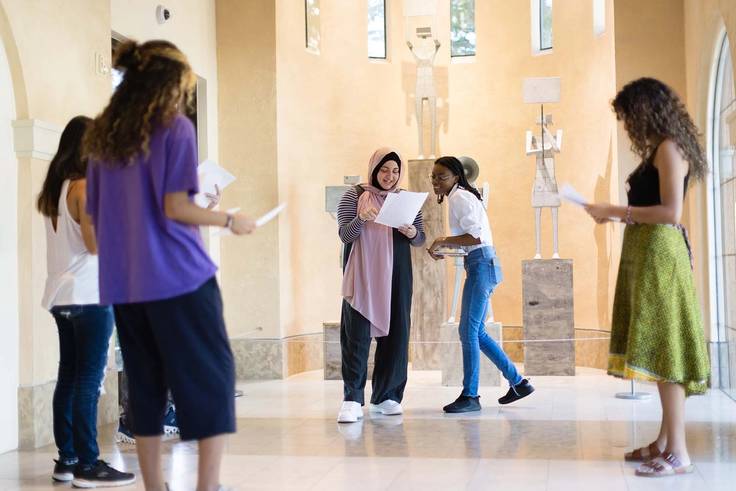
Moonwake: Ethnographic Performance of Healing from Racial Trauma
Research Team
- Tiara Ashurst ’23, biology major
- Ghina Fawaz ’22, psychology and theatre arts double major
- Hilary Cooperman, professor of theatre and performance
The Scoop
Think you can’t get further from the fine arts than the biology department? Think again. After working together on a virtual production of Ohio State Murders for the Annie Russell Theatre’s 88th season, biology major Tiara Ashurst ’23 and psychology and theatre arts double major Ghina Fawaz ’22 approached theatre professor Hilary Cooperman about producing an original play that would address BIPOC (Black, Indigenous, People of Color) trauma and healing. Both students were able to offer a unique perspective thanks to their extensive interdisciplinary study. Fawaz is a passionate advocate for mental health, while Ashurst brings a scientist’s sensibility to the way the pair sought to tackle questions surrounding the experiences of marginalized populations.
The project was funded in part through the Student-Faculty Collaborative Scholarship Program and partially through a diversity and inclusion grant from Rollins’ Diversity & Inclusion Council. Ashurst and Fawaz analyzed data from more than 30 interviews with BIPOC students before setting about turning their findings into Moonwake, an interactive, choose-your-own-adventure performance that follows the effects of racism as they spread through a contagious pathogen. As the virus infects more and more of the people on stage, the audience must make decisions that yield consequences in real time.
“In the process of making our idea a reality, we stumbled upon a word that felt too perfect to let go: ‘moonwake,’ the reflection of moonlight on a body of water,” adds Fawaz. “This word resonated not only with the story we were trying to tell, but with the impact we were trying to make within the Rollins and Winter Park communities. Change cannot occur without reflection, especially in the pursuit of anti-racism. Our show calls upon the audience to step into the community by embracing empathy and self-reflection.”
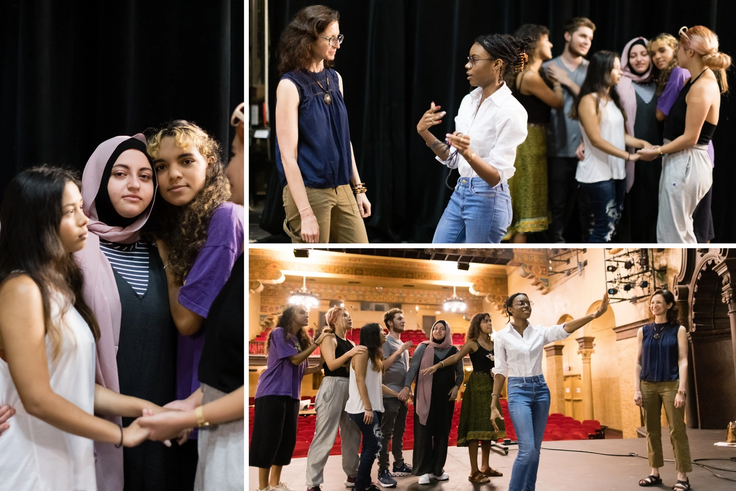
Real-World Application
The play was performed in the newly branded Rollins Museum of Art with the exhibition Art Encounters: Ally is a Verb as a backdrop. The location served to underscore the play’s major themes of racial trauma and healing, providing the audience with a lingering sense of allyship as an active, rather than a passive, pursuit. After a year of rising racial tensions spurred on by tragedies such as the death of George Floyd, the piece is a timely commentary on the College’s commitment to racial justice.
“Moonwake affords our students the opportunity to amplify and support BIPOC voices and stories,” says Cooperman. “This ties in directly into the theatre and dance department’s Anti-Racism Action Plan, which Ghina and Tiara have taken as their own clarion call to do what they can to realize its vision.”
Student Perspective
“I am a proud Lebanese American Muslim woman who is passionate about the utilization of art and mental health advocacy,” says Fawaz. “This project is the intersection of those passions, and the creation of this show has given me the gift of inspiration. Our research into the psychological impact of racial trauma, microaggressions, and racial bias toward BIPOC students will be something I carry with me well beyond graduation.”
What’s Next
The summer performances of the show were so successful that the theatre department is planning to produce a scaled-up version with Rollins student actors, directors, and designers. The limited show will run at Rollins Museum of Art for three performances during the weekend of January 28, 2022.
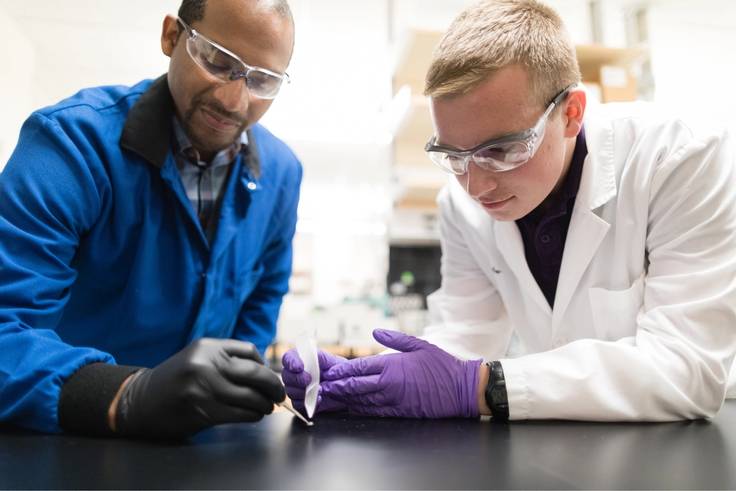
Pillared Metal Phosphates: The Route to Responsive Materials
Research Team
- EJ Broker ’22, chemistry and Spanish double major
- Brian Mosby, professor of chemistry
The Scoop
Two years ago, chemistry and Spanish double major EJ Broker ’22 started their collaborative research in what Broker fondly calls the “Mosby Lab.” This summer they continued their work studying the various applications of stimuli-responsive smart materials. Building on their previous work with a multilayered compound called alpha-zirconium phosphate (ZrP), the pair focused on testing the limits of ZrP by introducing carbon chain ligands of various lengths into the interlayer.
The goal of the project is to synthesize reactivity in smart materials, meaning materials that undergo some type of change in response to specific stimuli—anything from pH and temperature to specific wavelengths of light. The pair’s work was made easier this time around by the recent purchase of new hydrothermal reaction vessels and a programmable oven.
“Our reactions require very specific times, and it is important to end the reaction and turn off the oven at the correct time,” says Mosby. “The programmable function saved us many trips to the lab and reduced the odd timing we previously used for reactions. These reactions typically took 96 hours to complete. After such long reactions, it was always exciting to get good data confirming everything was going in the right direction.”
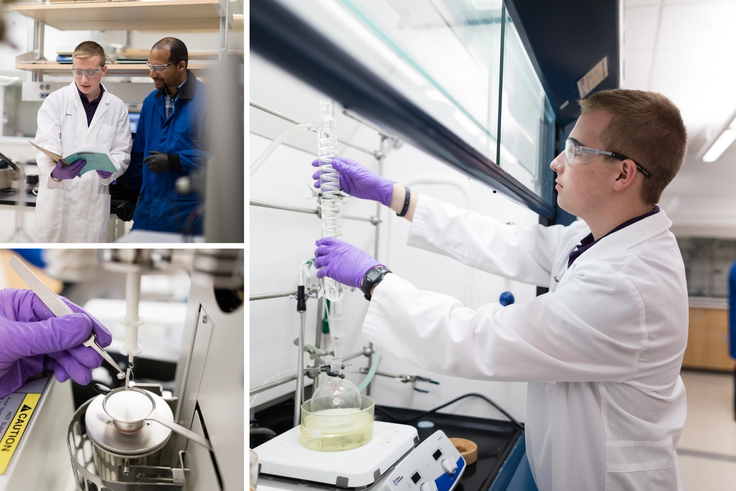
Real-World Application
Although Broker and Mosby’s work was focused on inorganic and materials chemistry, there were many interdisciplinary features of their research, which included the use of organic, physical, and other chemistries. The results of their project have the potential to be just as far-reaching, as the use of responsive materials touches nearly every aspect of science, from drug delivery in medicine to the use of smart materials to initiate (or halt) reactions in chemistry.
Student Perspective
“Ultimately, my years of research under Dr. Mosby’s guidance and mentorship have provided me with the relevant and much-needed experience a chemist requires in the lab,” says Broker. “And there is no teacher quite like experience. From here, my plan is to pursue my PhD in chemistry and eventually become a chemistry professor. My experience at Rollins, afforded to me through student-faculty research and supported by the outstanding chemistry department, has prepared me for the professional world more than I ever could’ve imagined.”
What’s Next
The two plan to continue their research on responsive materials throughout the academic year, with further work going to support Broker’s honors thesis and an eventual submission for publication in a scholarly journal.

See for Yourself
Get a feel for Rollins’ unique brand of engaged learning and personalized attention through one of our virtual or in-person visit experiences.
Read More
July 15, 2024
Rollins College Computer Science Professor Discusses AI and the Future of Work
Daniel Myers, an associate professor of computer science at Rollins College, provides expertise on how AI is changing the nature of work.
July 08, 2024
Gunter’s Book on Climate Change Receives Multiple Awards
Political science professor Mike Gunter’s book Climate Travels recently won awards from Foreword magazine and the American Library Association.
July 03, 2024
Rollins Welcomes Dean Lauren Smith
The 32789.com interviewed Lauren Smith, the new Dean for the Hamilton Holt School about her experience with adult education.
